15.1.3: Initial Skeletal Analysis
- Last updated
- Save as PDF
- Page ID
- 136475
While bioarchaeology and forensic anthropology have different goals and purposes, they both rely on skeletal analysis to reveal information about the deceased. Whether they aim to determine more information regarding an individual deceased for thousands of years (bioarchaeologists) or one who died within the last year (forensic anthropologists), they carry out the same basic steps as part of their analysis. They begin with seven steps or questions:
- Is it bone?
- Is it human?
- Is it modern or archeological?
- How many individuals are present or what is the minimum number of individuals (MNI)?
- Who is it?
- Is there evidence of trauma before or around the time of death?
- What happened to the remains after death?
Is It Bone?
One of the most important steps in any skeletal analysis starts with determining whether or not material suspected to be bone is in fact bone. Though it goes without saying that a forensic anthropologist or bioarchaeologist would only carry out analysis on bone, this step is not always straightforward. Whole bones are relatively easy to identify, determining whether or not something is bone becomes more challenging once it becomes fragmentary. For example, at high heat such as that seen on fire scenes, bone can break into pieces. During a house fire with fatalities, firefighters watered down the burning home. After the fire was extinguished, the sheetrock (used to construct the walls of the home) was drenched and crumbled. The crumbled sheetrock was similar in color and form to burned, fragmented bone, therefore mistakable for human remains (Figure 15.1). Forensic anthropologists on scene were able to separate the bones from the construction material, helping to confirm the presence of bone and hence the presence of individual victims of the fire. In this case, forensic anthropologists were able to recognize the anatomical and layered structure of bone and were able to distinguish it from the uniform and unlayered structure of sheetrock.
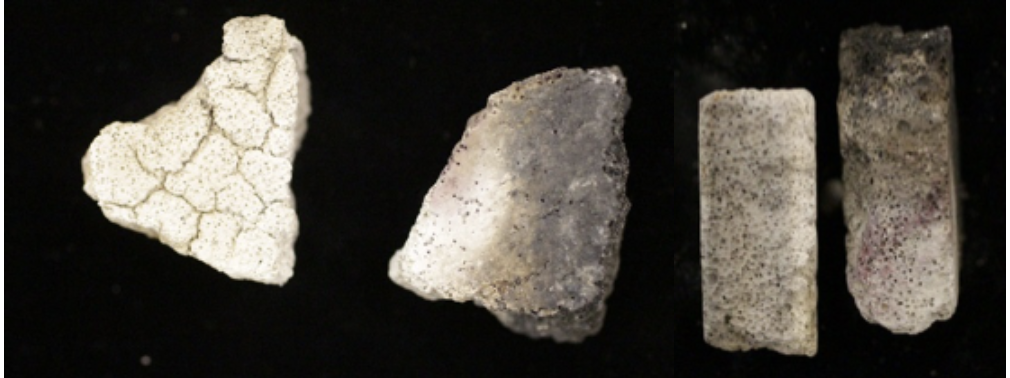 Figure \(\PageIndex{1}\): Example of burned sheetrock. Burned sheetrock used as building material appears similar to human bone but can be differentiated by the fact that it is the same density throughout.
Figure \(\PageIndex{1}\): Example of burned sheetrock. Burned sheetrock used as building material appears similar to human bone but can be differentiated by the fact that it is the same density throughout.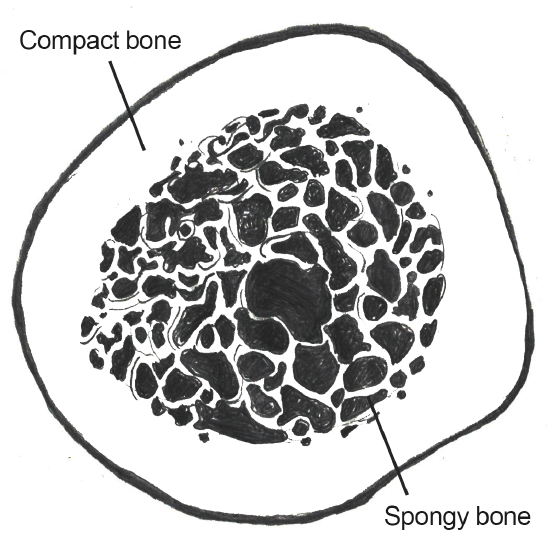 Figure \(\PageIndex{2}\): caption: Cross section of human long bone with compact and spongy bone layers visible.
Figure \(\PageIndex{2}\): caption: Cross section of human long bone with compact and spongy bone layers visible.As demonstrated by the example above, both the macrostructure (visible with the naked eye) and microstructure (visible with a microscope) of bone are helpful in bone identification. Bones are organs in the body made up of connective tissue. The connective tissue is hardened by a mineral deposition, which is why bone is rigid in comparison to other connective tissues such as cartilage (Tersigni-Tarrant and Langley 2017, 82–83; White and Folkens 2005, 31). In a living body, the mineralized tissue does not make up the only component of bone—there is also blood, bone marrow, cartilage, and other types of tissues. However, in dry bone, two distinct layers of the bone are the most helpful for identification. The outer layer is made up of densely arranged osseous (bone) tissue called . The inner layer is comprised of much more loosely organized, porous bone tissue whose appearance resembles that of a sponge, hence the name . Knowing that most bone contains both layers helps with the macroscopic identification of bone (Figures 15.2, 15.3). For example, a piece of coconut shell might look a lot like a fragment of a human skull bone. However, closer inspection will demonstrate that coconut shell only has one very dense layer, while bone has both the compact and spongy layers.
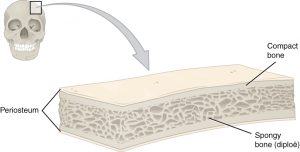 Figure \(\PageIndex{3}\): Cross-section of human cranial bone.
Figure \(\PageIndex{3}\): Cross-section of human cranial bone.Cranial anatomy is slightly different as compared to that of a long bone in cross section. The compact (cortical) bone layers sandwich the spongy (trabecular) bone. One layer of compact bone forms the very outer surface of the skull and the other lines the internal surface of the skull.
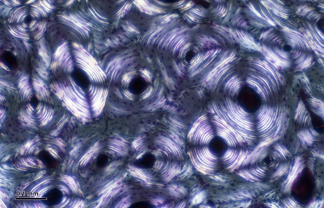 Figure \(\PageIndex{4}\): Bone microstructure (osteons).
Figure \(\PageIndex{4}\): Bone microstructure (osteons).The microscopic identification of bone relies on knowledge of osteons, or bone cells (Figure 15.4). Under magnification, bone cells are visible in the outer, compact layer of bone. The bone cells are arranged in a concentric pattern around blood vessels for blood supply. The specific shape of the cells can help differentiate, for example, a small piece of PVC (white plastic) pipe from a human bone fragment (Figure 15.5).
Is It Human?
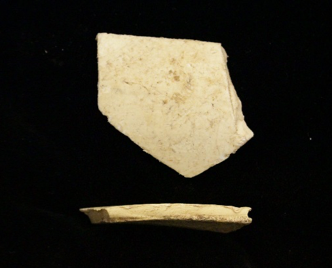 Figure \(\PageIndex{5}\): Fragments of plastic PVC pipe, such as those seen in this photo, may be mistaken for human bone.
Figure \(\PageIndex{5}\): Fragments of plastic PVC pipe, such as those seen in this photo, may be mistaken for human bone.Once it can be determined that an object is bone, the next logical step is to identify whether the bone belongs to a human or an animal. Bioarchaeologists must make this determination each time they come across remains at an archaeological site. Forensic anthropologists are faced with this question in everyday practice because human versus nonhuman bone identification is one of the most frequent requests they receive from law enforcement agencies.
There are many different ways to distinguish human versus nonhuman bone. The morphology (the shape/form) of human bone is a good place for students to start. Identifying the 206 bones in the adult human skeleton and each bone’s distinguishing features (muscle attachment sites, openings and grooves for nerves and blood vessels, etc.) is fundamental to skeletal analysis.
Nevertheless, there are many animal bones and human bones that look similar. For example, the declawed skeleton of a bear paw looks a lot like a human hand, pig molars appear similar to human molars, and some smaller animal bones might be mistaken for those of an infant. To add to the confusion, fragmentary bone may be even more difficult to identify as human or nonhuman. However, several major differences between human and nonhuman vertebrate bone help distinguish the two.
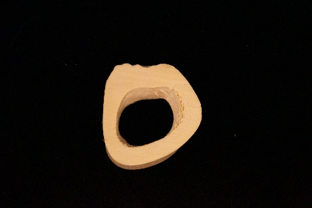 Figure \(\PageIndex{6}\): The compact layer of this animal bone is very thick with almost no spongy bone visible.
Figure \(\PageIndex{6}\): The compact layer of this animal bone is very thick with almost no spongy bone visible.Bioarchaeologists and forensic anthropologists pay special attention to the density of the outer, compact layer of bone in both the cranium and in the long bones. Human cranial bone has three distinctive layers. The spongy bone is sandwiched between the outer (ectocranial) and inner (endocranial) compact layers. In most other mammals, the distinction between the spongy and compact layers is not always so definite. Secondly, the compact layer in nonhuman mammal long bones can be much thicker than observed in human bone. Due to the increased density of the compact layer, nonhuman bone tends to be heavier than human bone (Figure 15.6).
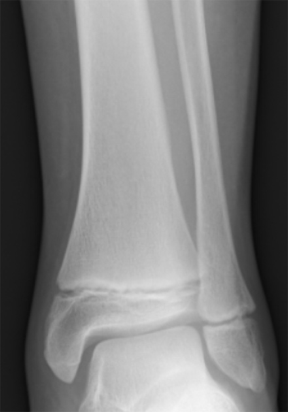 Figure \(\PageIndex{7}\): In this x-ray of a subadult’s ankle with the epiphyses of the tibia and fibula visible. The gap between the shaft of the bone and the end of the bone (epiphysis) is the location of the growth plate. Therefore, the growth plate gap is what separates the shafts from the epiphyses in the image.
Figure \(\PageIndex{7}\): In this x-ray of a subadult’s ankle with the epiphyses of the tibia and fibula visible. The gap between the shaft of the bone and the end of the bone (epiphysis) is the location of the growth plate. Therefore, the growth plate gap is what separates the shafts from the epiphyses in the image.The size of a bone helps determine whether it belongs to a human. Adult human bones are larger than subadult or infant bones. However, another major difference between human adult bones and those of a young individual or infant human can be attributed to development and growth of the epiphyses (ends of the bone). The epiphyses of human subadult bones are not fused to the shaft (Figure 15.7). Therefore, if a bone is small and it is suspected to belong to a human subadult or infant, the epiphyses would not be fused. Many small animal bones appear very similar in form compared to adult human bone, but they are much too small to belong to an adult human. Yet they can be eliminated as subadult or infant bones if the epiphyses are fused to the shaft.
Is It Modern or Archaeological?
As discussed earlier, bioarchaeologists are concerned with human remains from archaeological contexts, while forensic anthropologists work with modern cases that fall within the scope of law enforcement investigations. Accordingly, it is important to determine whether discovered human remains are archaeological or forensic in nature.
In many instances, bioarchaeologists work at known archaeological sites. Nevertheless, every bioarchaeologist and forensic anthropologist should begin their analysis by reviewing the context in which the remains were discovered. This will help them understand a great deal about the remains, including determining whether they are bioarchaeological or forensic in nature as well as considering legal and ethical issues associated with the collection, analysis, and storage of human remains (see “Ethics and Human Rights” section of this chapter for more information).
The “context” refers to the relationship the remains have to the immediate area in which they were found. The context includes the specific place where the remains were found, the soil or other organic matter immediately surrounding the remains, and any other objects or artifacts in close proximity to the body. For example, imagine that a set of remains has been located during a house renovation. The remains are discovered below the foundation. Do the remains belong to a murder victim? Or was the house built on top of an ancient burial ground? Observing information from the surroundings can help determine whether the remains are archaeological or modern. How long ago was the foundation of the house erected? Are there artifacts in close proximity to the body, such as clothing or stone tools? These are questions about the surroundings that will help determine the relative age of the remains.
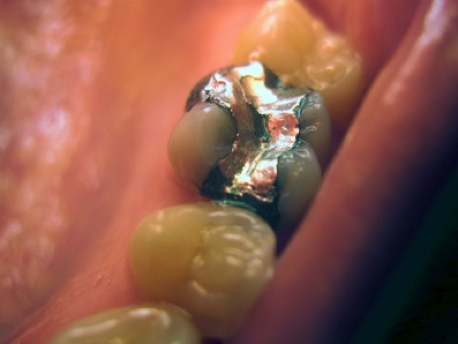 Figure \(\PageIndex{8}\): A human tooth with a filling.
Figure \(\PageIndex{8}\): A human tooth with a filling.Clues directly from the skeleton may also indicate whether the remains are archaeological or modern. For example, tooth fillings can suggest that the individual was alive recently (Figure 15.8). In fact, filling material has changed over the decades, and the specific type of material used to fix a cavity can be matched with specific time periods. Gold was used in dental work in the past, but more recently composite (a mixture of plastic and fine glass) fillings have become more common.
How Many Individuals Are Present?
What Is MNI?
Another assessment that an anthropologist can perform is the calculation of the number of individuals in a mixed burial assemblage. Because not all burials consist of a single individual, it is important to be able to estimate the number of individuals in both an archaeological and forensic context. Quantification of the number of individuals in a burial assemblage can be done through the application of a number of methods, including the following: the Minimum Number of Individuals (MNI), the Most Likely Number of Individuals (MLNI), and the Lincoln Index (LI). The most commonly used method in physical anthropology, and the focus of this section, is determination of the MNI.
The MNI presents “the minimum estimate for the number of individuals that contributed to the sample” (Adams and Konigsberg 2008, 243). Many methods of calculating MNI were originally developed within the field of zooarchaeology for use on calculating the number of individuals in faunal or animal assemblages (Adams and Konigsberg 2008, 241). What MNI calculations provide is a lowest possible count for the total number of individuals contributing to a skeletal assemblage. Traditional methods of calculating MNI include separating a skeletal assemblage into categories according to the individual bone and the side the bone comes from and then taking the highest count per category and assigning that as the minimum number.
Before beginning MNI calculations, however, it is important to make sure that all elements in the assemblage belong to the same species. If an assemblage contains both human and faunal (animal) elements, the assemblage should be divided into two separate groups. In a forensic context, it is likely that an MNI calculation is only necessary for the human skeletal remains. However, in an archaeological assemblage, it may be useful to calculate MNI for both the human and faunal remains. Faunal remains can contribute to a greater understanding of lifeways in past populations. For example, the age and sex profile of the animals at a site might be indicative of domestication. Large numbers of young male cattle bones and adult female cattle bones may indicate that the males were killed young while females were kept into adulthood. This pattern is consistent with cattle selection for captivity: adult males can be dangerous and aggressive, so they are killed young. On the other hand, females produce milk and are kept into adulthood.
Why Calculate MNI?
The determination of MNI is critical in both bioarchaeological and forensic contexts, as it allows anthropologists to establish an approximate number of deceased individuals within a burial assemblage (Adams and Konigsberg 2008). However, it must be recognized that unless a skeletal assemblage has a near-100% recovery rate for at least one type of skeletal element, the MNI will not provide an accurate estimate for the original number of individuals contributing to the burial assemblage (Adams and Konigsberg 2008, 243).
Determination of MNI is most applicable in cases of mass graves or commingled burials (Figure 15.9). The term commingled is applied to any burial assemblage in which individual skeletons are not separated into separate burials. Commingled assemblages occur in cases of familial burials (e.g., multiple family members buried in a single grave plot) and mass graves, possibly the result of genocide. However, it is important to remember that in any forensic context, MNI should be referenced and an MNI of one should be substantiated by the fact that there was no repetition of elements associated with the case.
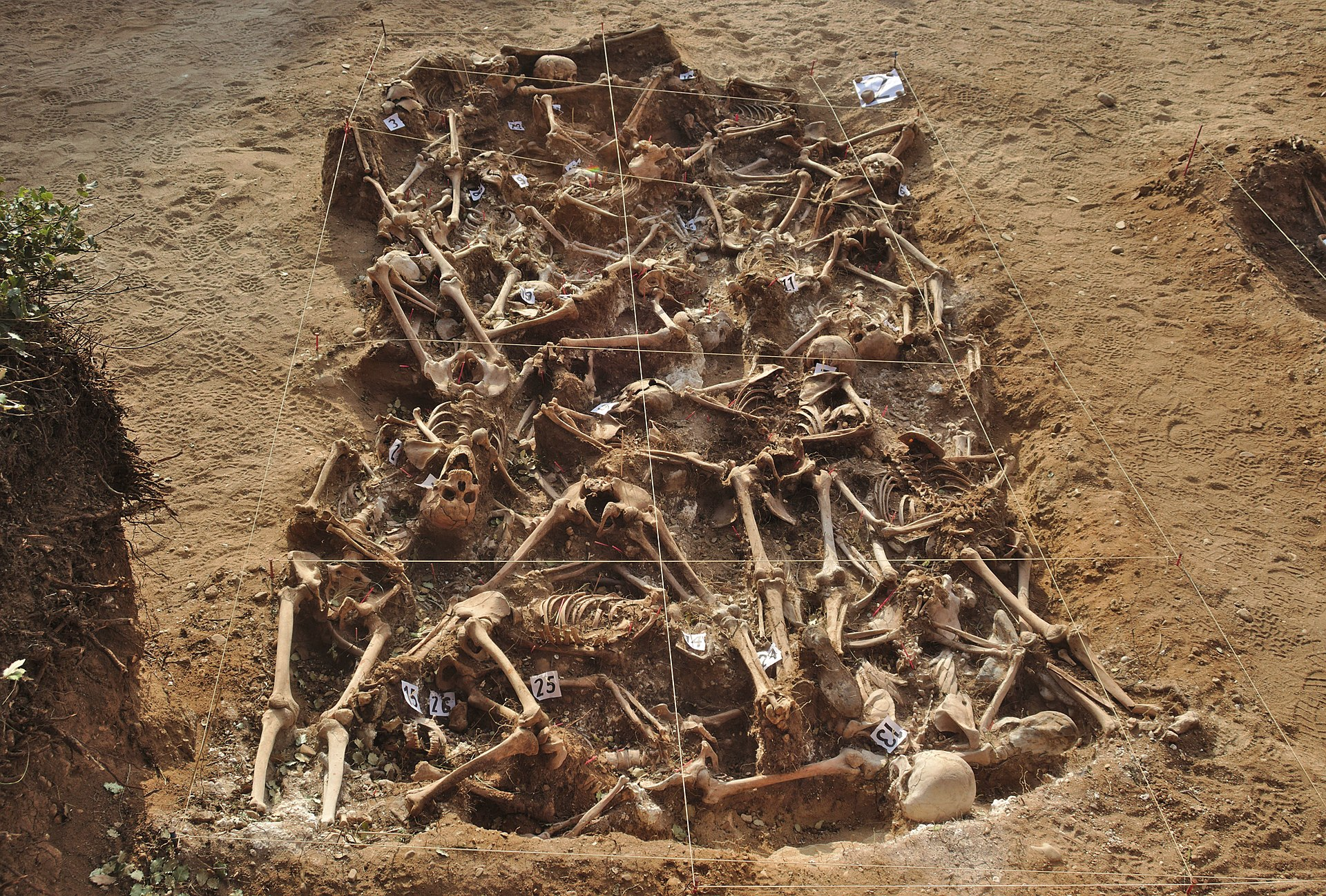 Figure \(\PageIndex{9}\): Commingled human remains.
Figure \(\PageIndex{9}\): Commingled human remains.
